The Battle of Fontenoy, or the Adventure and Victory of Moritz Saxon, Marshal of France
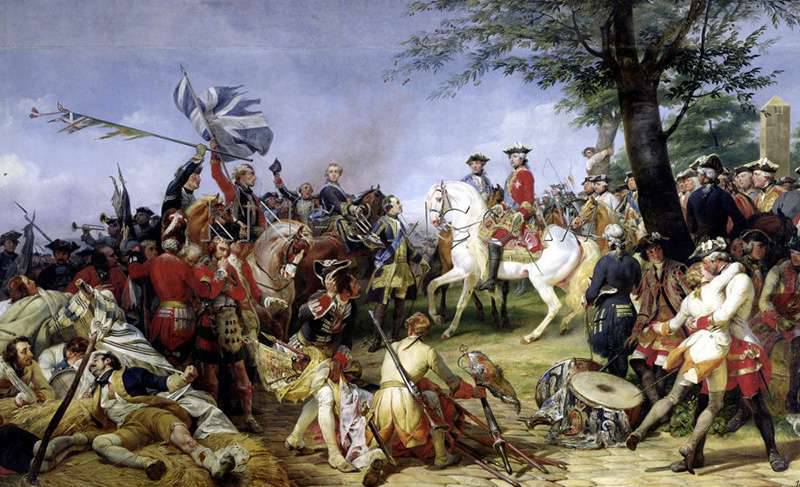
The 18th century in Europe — the century of enlightened monarchs, brilliant favorites and adventurers, philosophers and novelists — smelled of exquisite perfumes, gunpowder and blood. The dull mind of some shielded the dazzling splendor of balls and masquerades, the glory of others gleaming menacingly on the soldiers' bayonets and officer swords. Over the excessive luxury of palaces and elaborate baroque façades, slums proliferated, and dry drumsticks often made their way through the violin play of court orchestras.
The cannon vents in the “debate” about the Polish inheritance have not cooled yet, and the European rulers have already vigorously rubbed their hands on the eve of a new property dispute. In those days, the international arbitration court did not even know other terms that were difficult to pronounce on Voltaire’s contemporaries, so lawyers ’teams of several tens of thousands of people recruited, depending on their place of residence, for money or recruitment. Overwhelmed with plans and desires, statesmen frowned. Lush wigs from crowned and court heads showered with powder cards, which depicted the Habsburg Empire.
More recently, the mighty, Austria was experiencing hard times. From the conflict over the Polish inheritance, the country came out weak. 1738 ended with the signing of a separate peace war with Turkey, which was waged in alliance with Russia. Two years earlier, in 1736, at the age of 72, one of the most prominent commanders of the Hapsburg monarchy, Generalissimo Prince Yevgeny of Savoy, died. The treasury was empty, and the state of the army was pitiable.
The last representative of the male line of the Habsburg dynasty, Emperor Charles VI had no male heirs. Fate decreed that the heavy scepter of the Holy Roman Empire should have been taken over by his daughter Maria Theresia. The rules of succession, intertwined with traditions, were strict and precise: power was transferred to the heir, but not to the heiress. Conditions were created for a precedent, the essence of which was reduced to the medieval procedure of the all-German elections of the new emperor. The three hundred year rule of the Habsburgs hung in the balance. Understanding what the reason for unrest and other dangerous phenomena may be the interruption of the dynasty, Charles VI, at the dawn of his nearly thirty-year reign, decided to legally strengthen his precarious position with his heirs. In 1713, he issues the so-called Pragmatic Sanction, according to which the transfer of power to the emperor's daughter was allowed due to the absence of sons. The emperor spent a lot of time, effort and gold to gain recognition of this document from the neighbors. Neighbors nodded thoughtfully, wondering to themselves all the benefits of the situation. The old grumbler Yevgeny of Savoy urged his monarch not to rely on the paper guarantees of mercenary neighbors who would not fail to take advantage of the difficulties of Austria. The best guarantor of the Pragmatic sanction, in the opinion of the commander, was to be a well-armed and trained army. His opinion was not heeded.
On October 20, 1740, Charles VI passed away. The death of the emperor caused revival in European courts, and his reason was clearly not the fees for the memorial dinner. The messengers and messengers, who brought sad news for someone and good news for some, and neighbors of the monarchs began to give orders for the upcoming military campaign, which was to express their dissenting opinion on the Pragmatic sanction, had not yet taken a breath. All the promises and guarantees given to the late Charles VI now quickly gained the value and weight of the hussar's promise to marry a naive and trusting maid. Many neighboring states suddenly had territorial claims against Austria. Everyone referred to ancient rights and treaties, shocked with yellowed parchments with illegible signatures. The young king of Prussia Frederick II modestly claimed Silesia, the elector of Bavaria, Karl-Albrecht, expressed claims for all the possessions of the Habsburgs, guided by old dynastic ties. Spain put in its full-fledged five gold doubloons, citing historical family relationships. Among the crush of big and strong, little Saxony was pulling her hands towards the Austrian pie. In France, in the unfolding crisis, they saw the opportunity to deal with a longtime rival in Europe, to restore hegemony shaken after the reign of Louis XIV. The fighting began already in the spring of 1741 by the invasion of the Prussian troops in Silesia. Already on April 10, Frederick II and his field marshal Schwerin completely defeated the Austrians at Molvitz. The Bavarians soon entered Upper Austria and advanced into Bohemia.
In the current difficult situation, the young empress did not lose her presence of mind. Maria Theresia received a male upbringing - after all, her father initially prepared her for the role of head of state. She turned for help to the Hungarians. Hungary from 1687 was part of the Habsburg monarchy and has long been famous for its feudal freemen. At the September 11 1741 of the Pressburg Sejm, Maria Theresia earnestly turned to the local nobility for support, holding a six-month-old baby and the future Emperor Joseph. Her speech was greeted with an enthusiastic roar and swords snatched from the scabbard. The enthusiasm of the Hungarian gentry was fueled by the promises of additional liberties and privileges. The war grew - traditionally it has already touched the Italian possessions of the Hapsburgs. Hungarian nobility, fulfilling the promise, gathered an impressive militia, which strengthened the actual imperial troops.
England watched the escalation of the conflict with some alarm. The total collapse of Austria was not part of her plans - it would automatically strengthen the eternal and implacable rival, France. After careful analysis of debit and credit, the lords found it entirely appropriate to lend considerable sums to the Austrians in order to strengthen their defenses. Moreover, with the mediation of England, Maria Theresa signed a peace treaty with Frederick II in 1742, giving it to Silesia. Later Saxony joined him. By reducing the number of opponents of Austria to an acceptable amount, in London they considered it possible to take part in the enterprise as well. The formation of the 45-thousandth British army began in the Netherlands. Sardinian king Karl Emmanuel, who decided in the current turmoil to slightly grow his small state in alliance with France, was reassured by small concessions to the Austrian lands in Lombardy and a large English money prize. Karl Emmanuel didn’t care whom to support, and then he was paid, so the Sardinian kingdom joined the war in Austria. Another French ally, the Kingdom of Naples, was withdrawn from the war in a more direct but effective way. An English squadron arrived on the raid of Naples, including, among other things, six bombing ships. The squadron commander, Admiral Martin, politely demanded that the king observe neutrality and recall all troops who fought against Austria in northern Italy. Otherwise, the British were going to subject the city to massive bombardment, and His Majesty was given only one hour to think. The king agreed. Rested from battles, Frederick II rightly decided that Silesia alone would not be enough, entered into a secret alliance with France and re-entered the war against Austria. The whole war for the inheritance of Charles VI resembled an incessant banquet with a significant admixture of massacre: guests came without an invitation, ate, drank, fought, put up, left without saying goodbye, and came back again. The center of the confrontation of England and France, except for the colonies and the ocean, became the Netherlands. It was here that the star of Marshal of France Moritz of Saxon shone.
Path to the marshal's baton
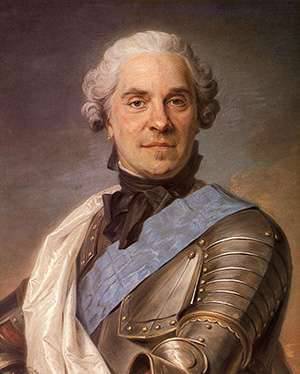
The future commander of France was born on October 28 1696 in Lower Saxony. His mother was Countess Aurora von Königsmark. Father was Augustus II, Elector of Saxony and King of Poland, known as Augustus the Strong. Rumor and gossip attributed more than 300 illegitimate children to the loving monarch, and Count Moritz was one of this impressive cohort. Before 12, his father paid for his studies, and then he gave to the care of the adventurer known at that time, Count von Schulenburg. The boy was given the rank of ensign and in 13 years he was sent to fight in Flanders in the army of Yevgeny of Savoy. Moritz personally participated in the battle of Malplak. At the time of the signing of the Peace of Utrecht, which ended the war for the Spanish inheritance, he was 17 years old. Moritz had already had considerable combat experience, having managed to make war in Flanders and Pomerania.
In 18, the young man is married against her will to the 14-year-old owner of a huge dowry, Victoria von Leben. The young spouse in his own way disposed of the condition of his wife, holding on her money in perfect order and magnificence the cavalry regiment and a certain number of women. He liked military craft - in the outbreak of the war of Austria against the Turks, he took part in the siege of Yevgeny of Savoy in Belgrade. The financial resources of his wife were exhausted by his efforts before her patience, and Moritz decided to switch to the French service, considering it more promising. Not distinguished by the modesty of morals, the high society of Paris gladly accepted fresh replenishment into its ranks. The young man becomes a close friend of the regent of the duke of Orleans, who ruled the state between the reigns of Louis XIV and his great-grandson Louis XV. Received under the command of the regiment, consisting of German mercenaries, Moritz took up his thorough training, devoting a lot of time to fire training and tactics.
The capital of France was filled with temptations - they themselves found a way to him. The novel with the most famous actress of that time, Adrienne Lecouvreur, became resonant even in the Parisian elite, not at all inclined to surprise. After all, behind the Count of Saxony (his father honored this title in 1711), or simply Sax, the reputation of a rough martinet lasted. This was not entirely true - Moritz devoted a significant amount of his young time to the study of treatises on fortification and military art, mathematics and other sciences. The condition of his young wife has long since been turned to the wind, their marriage has been dissolved. In 1725, the throne of the Duchy of Courland was vacant, and the young man had a thought completely in line with the realities of that era to take possession of him. The widowed duchess of Courland, none other than Anna Ioannovna, the niece of Peter I, herself was not opposed to becoming the head of a small, but state, since she occupied the position of regent. The Comte de Sachs (as Moritz was called in France) decided to give her all possible help in this, to marry a resilient widow, and thus to unite their claims. For the implementation of such a bold idea needed appropriate finances. Many women in Paris willingly helped the count in his enterprise, and his beloved, Adrienne Lecouvreur, sold her jewelry. Equipped with everything necessary and, above all, with courage and adventurism, the graph went to woo.
He made a much greater impression on the Duchess of Courland than she did on him, nevertheless, the operation was continued. The count settled in the palace and healed in a big way. The Courland parliament (lantag) approved Moritz of Saxony as the new Duke of Courland, and Anna Ioannovna herself agreed to the marriage. But then big politics intervened in matters of the heart. The vassal duchy was a sphere of interests of Russia and people from the outside, all kinds of counts with a tarnished reputation, were not welcome here. In the spring of 1727, when Empress Catherine I died, Alexander Menshikov, who for some time became the sole ruler of the empire, decided to finally understand the Courland politics. He ordered General-General-Lassi to join the duchy at the head of a contingent from several regiments and to expel Moritz back home. Russian officers arrested the very numerous retinue of the duke and his office. Moritz himself, with a detachment of 300 people, relocated to Fishholm Island on Lake Usmaitensky, where he dug in, erecting some fortifications. Lassie calmly camped away, not attempting to storm. The adventurer’s instinct told Moritz that Paris might be worth a Mass, but the Duchy of Courland was completely incomparable in cost with its own head. Therefore, under the cover of darkness, the ex-duke fled from the island in a boat. His detachment surrendered to the Russian troops. There is another version, according to which the unlucky groom was specially discredited before the widow. Seeing home at night one of the duchess's maids of honor, he was very inappropriately identified by an old servant-servant who raised the alarm. The shares of Count de Sachs exposed in the eyes of Anna Ivanovna fell with a deafening roar. Whether the grandmother, who had shouted so inappropriately, was an agent of the Russian special services, the romantic story is silent about this.
Having returned to France, the earl, embarrassed in the dispensation of a profitable party, did not miss and did not lose heart. Soon the conflict that went down in history as the War for the Polish Succession (1733 – 1735), caused by the death of Moritz's father, Augustus II, began. In this confrontation, France supported her candidate for the Polish throne, the father-in-law of Louis XV, Stanislav Leschinsky. The French king was married to his daughter Maria. The fighting between the French and Austrian troops unfolded in Italy and Germany. Ironically, Moritz was now fighting against his former commander and mentor, Prince Eugene of Savoy. Earl especially distinguished himself in the summer of 1734 during the siege of the fortress of Philipsburg in Germany. French troops commanded the Duke of Berwick, who was killed by the neatly released core during the bypass of trenches. Nevertheless, the garrison of the fortress was forced to surrender. Comte de Sachs, having shown himself from the most positive side as a skillful and experienced commander, ended the war as a lieutenant general. Starting from this period, the career of Moritz starts to go up steadily. He was a truly talented and gifted man and commander. Not the last role in the ascent of his star at the court was an acquaintance with the Marquis de Pompadour, which had a great influence on the king. The all-powerful favorite was supportive of de Sax, although she considered him "not understanding anything in the subtleties of love."
The new war, already for the Austrian inheritance, brought the count real glory. With the outbreak of hostilities, the lieutenant general was sent at the head of an expeditionary detachment to help the Elector of Bavaria, whose troops invaded Austrian Bohemia. It was under his leadership that Prague was taken on the night of 26 on 27 on November 1741 of the year. At the same time, the count showed his qualities as a commander. The fortified city was subjected to false attacks from various sides, preventing the enemy from concentrating reserves in one direction. When the Austrians in their attempts to repel the attack exposed a number of sites, Moritz Saxon ordered to attack already truly and in the most vulnerable place. Having approached the walls, the French found out that their assault ladders were not of sufficient length. The general, finding nearby the gallows, ordered the stairs to be extended by short ladders leading to the parapet, and an assault group of fifty people successfully crossed over the obstacle. The guard, taken by surprise, was hacked to the ground. Prague was taken with little blood, after the assault there was no looting. Moritz Saxon, on pain of being shot on the spot, forbade his soldiers to scatter around the city and rob.
The following year, 1742, under his leadership of 19, April, the fortress of Eger was taken, which was considered impregnable. France experienced a shortage of talented high-level military leaders, and the successes of the Austrians became more and more obvious. At court, they begin to interpret that the Protestant Moritz of Saxony may be appointed a marshal. There was no particular choice for Louis XV, who personally knew the commander well. Contrary to the intrigues of 26 detractors, March 1744 of Moritz Saxon is awarded the title of Marshal of France. The king entrusted him with organizing the landing in England of the claimant to the English throne from the house of the Stuarts, Carl Edward. The troops intended for the landing began to concentrate near Dunkirk, but the bad weather and vigilance of the British prevented this undertaking.
Marshal received command of the French Moselle army, operating against the Austrians in Alsace. His actions were successful, and in 1745, he is already leading the invasion of the Austrian Netherlands. There was concentrated almost 50-thousandth allied group, which included British, Dutch and Hannover troops. Commanded this army, eloquently called the "Pragmatic Army", William Augustus, Duke of Cumberland, the third son of King George II. The server direction was considered a priority by the French command. King Louis XV himself set out on a campaign together with the army, with his very numerous retinue, including all sorts of experts, experts and consultants, the practical benefits of whose activities were nil. All this motley richly dressed crowd only interfered with the normal functioning of the headquarters with its intrigues and useless advice. Moritz himself suffered greatly from dropsy, he was transported in a special carriage. When he met Voltaire, who asked how he could participate in a military company in such a painful state, the count replied: "This is not about life, but about action." He prepared his plan for an attack in Flanders in the fall of 1744, taking into account the strengths and weaknesses of his troops and the enemy.
Offensive in Flanders. Battle of Fontenoy 11 May 1745 of the year
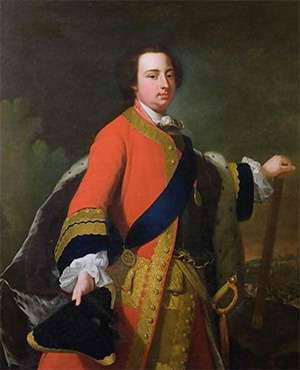
Given their superiority at sea, the Allies could not only concentrate a large army in the Austrian Netherlands, but also provide it with everything they need. Large warehouses of provisions, ammunition, ammunition were established in Ghent, Tournai and Audenarde. 20 April 1745, full of hope for glory and a desire to reach Paris in triumph, 24, the Duke of Cumberland, reached Brussels, the main gathering point of the Allied forces. In a report home, he said that he had 31 thousand infantry and 12 thousand cavalry. However, all the suitable reinforcements brought the army to 50 – 55 thousand people. Two experienced generals assisted in the command of the young duke: Austrian Count Koenigsek and the commander of the Dutch contingent, Prince Waldeck. Soon they were joined by General de Wendt, who led the Hanoverians.
Moritz Saxon left Paris for the 31 March army. On April 20, he was already in his operating base in Maubeuge, where, according to various estimates, 95 thousand people were concentrated (70 thousand infantry and 25 thousand cavalry). The campaign was decided to start immediately. Already on April 21, the French avant-garde headed north. Marshal's plan was to take control of the entire upper mouth of the Scheldt, that is, the heart of the Austrian Netherlands. In addition, it was supposed to capture a number of enemy cities and fortresses - first of all, Ghent and Tournai, thereby depriving the enemy of the reserves necessary for conducting combat operations. The cavalry corps of Count d'Estre made a fraudulent maneuver in the direction of Mons, which misled the Duke of Cumberland and the generals who were with him about the forthcoming actions of the enemy.
While the Allies trampled near Brussels, collecting and processing conflicting intelligence information in anticipation of the appearance of the main French forces in Mons, Moritz of Saxony approached the fortress of Tournai and besieged her on April 30. His plan was to lure the enemy into a siege threat to an important fortress and defeat before the Pragmatic Army receives additional reinforcements. Lingering allies (the Duke of Cumberland had no data for a long time, neither where the French were exactly, nor what their numbers were) approached the outskirts of the Tour 9 in May and ran into enemy pickets. Marshal fruitfully used the time allotted to him in choosing a position convenient for defense near the village of Fontenoy, where they noticed the heights suitable for the location of artillery.
The positions of the French army were well fortified. They consisted of supporting each other with redoubts, barricades, blockages, and spotted. Leaving the Marquise of Dreux-Breze from about 21 thousand people to block Tournai, the rest of the army took up positions between the villages of Fontenoy and Antoine. Both armies were roughly equal in numbers. The allies had 53 thousand people in 52 battalions and 85 squadrons (21 thousand British, 8 thousand Hanover, 22 thousand Dutch, 2 thousand Austrians) and 93 guns. The French had 48 thousands of people in the 55 battalions and the 101 squadron (32 thousand infantry and 14 thousand cavalry) with 80 guns. The enemies of the marshal immediately began to whisper to the king about the need for retreat, but contrary to expectations, the monarch publicly supported his commander, urging him unconditionally to obey his orders and be the first to set an example in this. The king had the wisdom to trust the professionals, not the decorative courtiers. In addition, the romantic story tells that Louis made a promise to his former and deceased mistress, Duchess de Chateaurus, to personally visit the battlefield, like a real monarch. So the king, accompanied by the young Dauphin, went to the position.
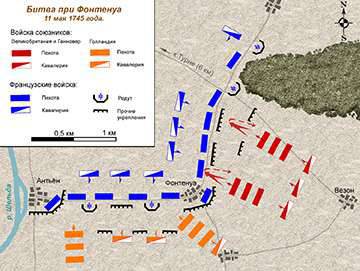
In 2 o'clock in the morning 11 May, the Allied forces finished the deployment to attack. The British and Hanoverians were located on the right flank, the Dutch and a small Austrian contingent on the left. Soon, a large battery, which, according to various estimates, from 40 or 50 guns, opened fire on French positions, firing, albeit from a long distance. This bombardment lasted almost three hours. The French soon began to respond. One of the first cores was seriously wounded in the leg by General James Campbell, who at the time of the battle was 73 of the year. Before his death, the old warrior calmly remarked that he, it seems, had already danced his own.
By 6 in the morning, the Allies moved to the active phase of the battle. Their main blow was carried out in the flank. The idea of the Duke of Cumberland and his advisers was to bring down the French left wing and the subsequent general attack. The attack was led by brigadier general Ingolsby with two regiments of infantry, Scottish highlanders and attached to strengthen the Hanover regiment. Under the drumbeat the Allied battalions began to move. Ahead of them was waiting for the forest of Barry, which, to the chagrin of the British, was busy with French arrows. Ingolsbi stopped and asked for instructions from the authorities, because he doubted the number of the enemy - I didn’t want to crawl into the woods. The Duke of Cumberland, personally galloping to the scene, made a suggestion to the brigadier general about the benefits of exploring the forest edges. All this time, the thick lines of the Allies were absolutely idle and soon became a convenient target for the French artillery, which was abundantly devastating their ranks.
On the right flank, things went a little better. Firstly, the cavalry attacking here remained at the very beginning without command (old Campbell was the commander of cavalry), secondly, General Waldeck, who controlled this place, finished concentrating before the allied right flank, but did not have accurate information about the quality of the French fortifications. The advancing Dutch and the cavalry following them were met with dense rifle volleys from the French redoubts. By the beginning of the eleventh the first series of Allied attacks failed - they were repulsed in all directions. The village of Fontenoy and the redoubt of Eu, key French positions, were not taken.
The Duke of Cumberland, regrouping his forces, decided to attack again, striking the main blow in a narrow place between the forest of Barry and Fontenoy. This was the weakest point of the French position - Moritz Saxon believed that this place was well shot through with artillery, and did not build redoubts here. The Dutch and Highlanders transferred here struck the village. The Scots attack was frantic and impetuous. The choice infantry brigade of Dauphin, which defended Fontenoy, met the attackers with heavy fire. The Dutch were the first to run, only courageous Highlanders broke into French positions and were beaten off with heavy losses. In the direction of the main attack, the Duke concentrated almost 15 thousand infantry and cavalry, built in six lines. The British attacked under artillery fire under the drumbeat. Artillery inflicted heavy losses, but there were concentrated the best and most efficient units, including the Guard. The French trembled and began to retreat.
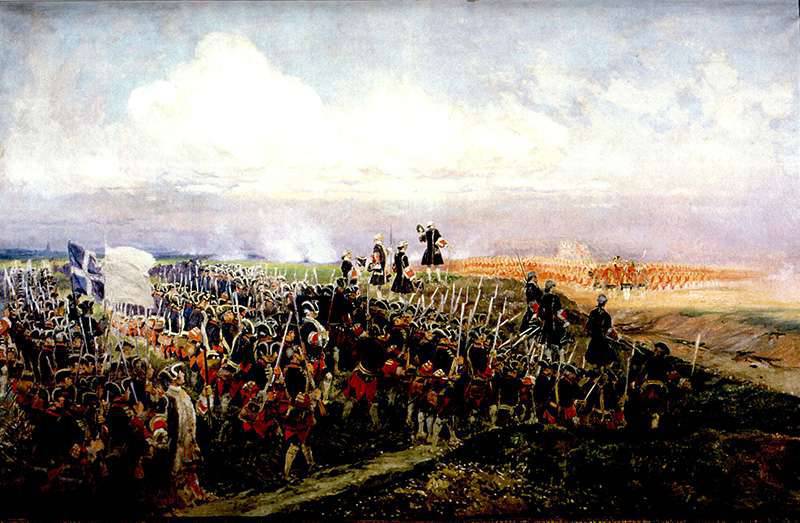
The French and British Guardsmen encountered on the battlefield, and it was here that the legendary incident occurred when the lieutenant of the Guards grenadier Charles Hay took off his hat, took out a flask, drank from it and greeted the French, inviting them to shoot. According to another version, the gallant lieutenant expressed the hope that the enemy would not run as hastily as it was before. French officers were no less amiable. At this critical moment in the battle, the courtiers began to persuade Louis XV to leave the battlefield, for "all of course," but Marshal Moritz stopped the emerging panic in the bud. Grimacing in pain, he left his stroller and climbed into the saddle. Against the British pushing through the line, all cash reserves were thrown, including heavy cavalry and Swiss guards. The Duke of Cumberland personally encouraged his fierce fire shelves. French attacks slowed his progress.
Marshal Moritz received information that the attack on Fontenoy successfully repulsed, and ordered to transfer the Dauphin's brigade to a threatening direction, leaving only the barriers in their previous positions. The Irish Brigade, formed from immigrants, was thrown into battle, famous for its "love" for the British. The Marshal was taking a risk, exposing other sections of the line, but, as it later turned out, the risk was justified. The battle went on a dagger distance - both sides suffered losses. The British and French exchanged ridicule and ironic courtesies, but gradually the pressure on the allies increased. When several horse-drawn artillery batteries were pulled to the scene of the crisis, the scale finally dropped in favor of Moritz Saxon. Bleeding Englishmen began to retreat in a relative order, despite the heavy losses and the continuing fire. The pursuit of the enemy was limited - the French cavalry was in complete frustration after repelling an enemy attack.
The losses of the parties were great: the Allies lost from 10 to 12 thousand, the French - 6 or 7 thousand. In Western Europe, it was the bloodiest battle since the famous battle of Malplak in the 1709 year. In the evening, crowded with impressions, King Louis XV, along with the Dauphin Louis Ferdinand, visited the battlefield dotted with the dead and dying. To the shocked youth, he said: “See, how much blood is worth the triumph. The blood of our enemies is also human blood. True glory is to keep from it. ” The battle of Fontenoy was the last battle in which the king of France took part.
The company's further course in the Netherlands was favorable for the French. Marshal cleared key fortresses from enemy garrisons, inflicted defeat on Allied troops in 1746 at Rock, and in 1747 in a bloody battle at Laufeld, where he again met Duke of Cumberland. The successful actions of the Count de Sachs allowed the return of the shaky military prestige of France. The war for the Austrian inheritance ended in 1748 with the signing of the Aachen peace, which generally preserves its pre-war status. For services to the crown, Moritz was awarded the title of Chief Marshal of France, the penultimate in history. The commander died at the age of 54 years, leaving behind him the treatise “Reflections” written in his own hand, where the marshal talked about war and military art. In it, he proves the need for a permanent personnel officer reserve and universal military service. The book was very popular in the military circles of Europe, which was already approaching a new large-scale conflict, called the Seven Years War.
Information